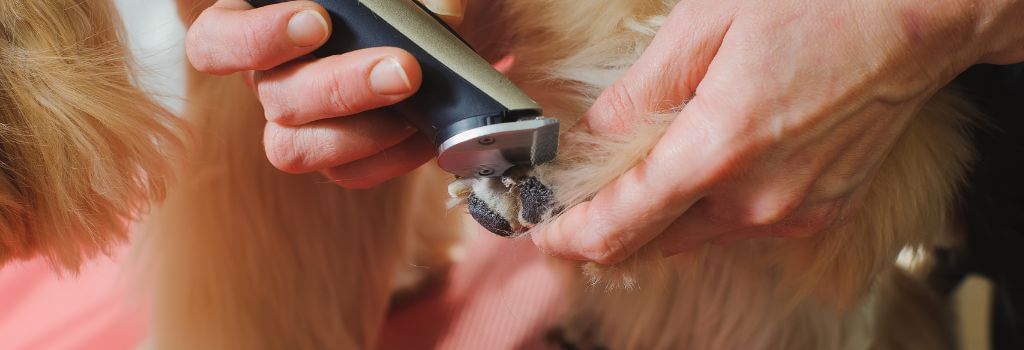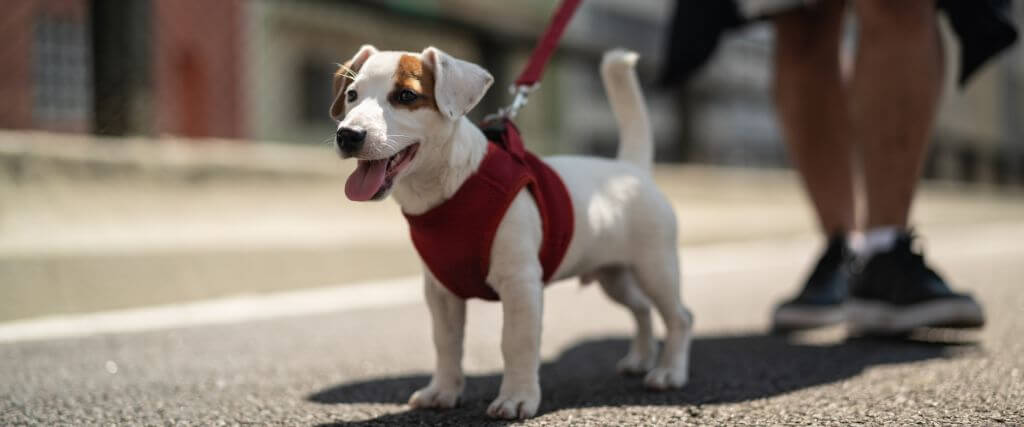When owners have concerns about their dog and the temperature outside, they’re usually thinking of the dangers of heat exhaustion or overheating. But in the summer months — or year around in areas with regularly warm climates — there are other heat-related dangers that owners should be cognizant of, including paw burns and blisters.
Learning how to recognize what conditions put your dog’s paws at risk, as well as what proper paw protection and care looks like, can keep your dog healthy, active, and happy all summer long.
Is It Too Hot to Walk My Dog?
If you’re asking yourself, “Is it too hot to walk my dog?” chances are, it probably is. When in doubt about how hot it is, it’s a good idea to plan your walk for another time or opt for some indoor playtime to help burn off some energy, while staying cool and safe.
Paw pad burns, heat exhaustion, and dehydration are all real and dangerous conditions that dogs can face when exposed to extreme heat. While it’s important to maintain your dog’s physical activity, it’s even more important to adapt your routine to the weather.
Dog Paws & Hot Surfaces: A Recipe for Disaster
A dog’s paw pads are designed to be tough and help absorb shock from running, jumping, and walking, but that doesn’t mean they’re immune to injury. Paw pads are filled with nerve endings and blood vessels that help in regulating temperature, but this makes them sensitive to both extreme temperatures and injuries. On hot days, heat-absorbing surfaces like asphalt, concrete, and sand can become dangerously hot, often exceeding temperatures of 120°F. When bare paws make contact with these hot surfaces, damage can be done within seconds. We’re talking burns, blistering, and peeling. All of these injuries can leave your dog in pain and out of commission for several weeks.
A good rule of thumb for determining if pavement or another surface is too hot for your pup’s paws is to test the temperature on your own skin first. To do so safely, place the back of your hand against the surface in question; if it’s too hot to hold there for at least 10 seconds, then it’s too hot for your dog’s paws to walk across.
6 Ways to Protect Dog Paws in the Summer Heat
While burnt paw pads are treatable, it makes a lot more sense to avoid burns in the first place. Trust us, your dog will thank you!
To help you get started on better paw care for your dog, we’ve put together six of our top tips for paw protection in the summer heat. By following these recommendations and making a few simple changes to your routine, you and your pup can enjoy the warm weather without any burns or injuries, putting a damper on your summer fun.
1. Avoid Hot Asphalt, Concrete, and Metal
Pavement and metal surfaces can get very hot very quickly on warm summer days, especially if they are in direct sunlight. Even if the outside air temperature feels tolerable, these surfaces can reach temperatures well beyond 100°F, making burnt dog paws a real concern for those who live in or frequent heavily paved areas.
Hot sidewalks, roads, and parking lots may all seem like common sense to avoid as part of this recommendation, but metal surfaces are something owners often forget about. Now, you may be thinking, “My dog never walks across anything metal!” But more often than not, that isn’t true; our dogs can come into contact with these surfaces more often than you’d think.
A few metal surfaces that dogs — especially in urban areas — may come in contact with include:
- Manhole covers and utility access lids: Often found on sidewalks and streets, these metal covers absorb and retain a lot of heat, especially in direct sunlight.
- Storm drain grates or sewer grates: Found along curbs or in parking lots, these metal surfaces can become extremely hot and may also trap paws if the spacing between bars is too wide.
- Boat docks or ramps: Many docks, especially aluminum ones, heat up quickly under the sun and can cause burns if your dog walks across them barefoot.
- Truck beds or tailgates: If your dog jumps into the back of a truck, the metal surface can be scorching, particularly if the vehicle has been parked in the sun.
- Metal stairs or fire escapes: In urban settings or multi-level buildings, metal staircases exposed to the sun can pose a burn risk during walks or outings.
- Metal park benches and tables: If your dog jumps up to sit with you or walks across a metal surface in a play area, the heat can be intense.
- Construction plates or temporary covers: Large, flat metal plates used in roadwork or sidewalk repair can reach high temperatures and are common in city environments.

2. Plan Your Walks and Playtime Accordingly
Walks and outdoor play time are usually a pretty routine part of a dog’s daily schedule, and that doesn’t have to change just because it’s warmer out. You may just need to adjust your usual walking route or schedule. With a little extra planning and attention to detail, you can keep doing your favorite outdoor activities without worrying about your dog’s paws getting burned.
If you can, plan your route for walks along shaded areas, avoiding surfaces that are exposed to intense, direct sunlight, like those we discussed above. Walking your dog or scheduling playtime during the cooler hours of the day, or opting for grass or dirt trails instead of sidewalks and roads, can also make a big difference in how hot the ground is and how likely your dog is to sustain a paw pad burn.
If it’s really hot, it can also be a good idea to keep walks or playtime on the shorter side to prevent dehydration and heat exhaustion in addition to paw burns. Treasure hunts, tug of war, and playing with bubbles are all great options for helping your dog burn off some extra energy indoors and make up for the time you lost on your outdoor fun.
3. Carry Your Dog Over Hot Surfaces
If you can’t plan your walks or outings to completely avoid hot pavement or other surfaces, you can always carry your dog instead. Avoiding hot surfaces isn’t always feasible in every situation, like if you have an afternoon vet appointment and need to walk across a parking lot or need to climb metal steps leading up to your apartment, but carrying your dog can help lessen the risk of them damaging their paw pads.
This option is typically more practical and easier to manage for small and toy breed dogs, as well as puppies. For larger dogs, you can lay down a towel, cooling mat, or use temporary paw covers to protect their feet during short transitions across hot surfaces.
4. Use Booties to Protect Those Dog Paws
Speaking of foot protection, things like dog booties are perfect for creating a physical barrier between your dog’s paws and hot surfaces. Good booties should be lightweight, breathable, and nonslip. They should also fit a little more snugly, without restricting any of your dog’s movement.
Wearing booties can be a little awkward for your dog at first, but with some time and perseverance — and maybe a little bit of practice at home — most dogs adjust well to them and don’t seem to mind putting them on before walks or trips outside.
5. Take Post-Walk Paw Care Seriously
Taking the extra time to assess your dog’s paws after a walk can go a long way in keeping their paws healthy and identifying any injuries early on. After walks, check your dog’s paws for any signs of redness, cracking, blistering, or other injury. These are all signs of a burn and will need prompt treatment to prevent complications and infection.
After giving your dog’s paws a once-over, it’s good to get in the habit of gently wiping your dog’s paws with a cool, damp cloth to remove debris, dirt, or residues from sidewalks or grass that may cause irritation. Not only can this keep your dog’s paws in better condition, but it can also help keep your home that much cleaner — a win-win in our book.

6. Keep Up With Paw Grooming Needs
The care your pup’s paws need in the summer doesn’t end with post-walk wipe downs. Proper grooming is essential to keeping your dog’s paws cool and comfortable, as well as preventing unnecessary injuries.
An often overlooked aspect of grooming that becomes exceptionally important in warmer weather is trimming the fur that is present between the paw pads. During the summer, dogs are more likely to walk on hot surfaces, play in water, or run through grass and dirt. If the fur between their paw pads becomes long or matted, it can hold onto heat from pavement, retain moisture from puddles or sprinklers, and collect small particles like gravel, burrs, or plant material. This combination not only increases the risk of discomfort and friction while walking but can also lead to skin breakdown, fungal infections, or painful hot spots between the toes.
Nail care and trimming are typically already a part of a responsible dog owner’s grooming routine, but it can’t hurt to remind you! Make sure your dog’s nails are kept at a healthy length, as overgrown nails can cause the paw to splay or shift pressure unnaturally, increasing the risk of pad injury.
By proactively addressing these paw care needs, you can ensure your dog's paws stay healthy and resilient, allowing them to enjoy all the summer fun safely and comfortably.
If you have questions and you'd like to reach out to us, you can call us directly at (253) 857-7302, or you can email us at [email protected]. Don't forget to follow us on social media Facebook, Instagram.

